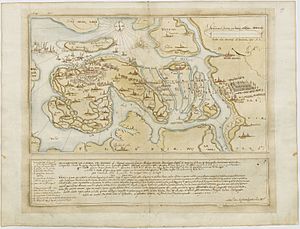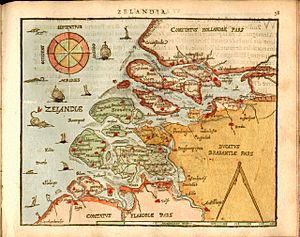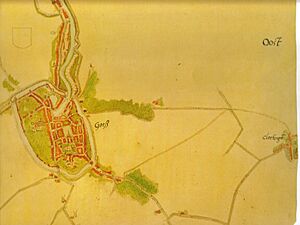Relief of Goes facts for kids
Quick facts for kids Relief of Goes |
|||||||
|---|---|---|---|---|---|---|---|
| Part of the Eighty Years' War | |||||||
 The Siege of Goes, 1572, by Petro Le Poivre. |
|||||||
|
|||||||
| Belligerents | |||||||
| Commanders and leaders | |||||||
| Strength | |||||||
| 7,000 | 3,000 | ||||||
| Casualties and losses | |||||||
| 800+ killed | 6 drowned | ||||||
In August 1572, the city of Goes in the Netherlands was under attack. This happened during the Eighty Years' War, a big fight between the Dutch and Spain. Dutch soldiers, helped by English troops from Queen Elizabeth I, were trying to capture Goes.
This attack on Goes also put the nearby city of Middelburg in danger. Middelburg was also being attacked. It was impossible to send help to Goes by sea. So, about 3,000 Spanish soldiers, led by Cristóbal de Mondragón, did something amazing. They walked across the Scheldt river at night. They walked for 15 miles in water that was sometimes up to their chests!
When the Spanish soldiers arrived by surprise, the Dutch and English troops had to leave Goes. This allowed Spain to keep control of Middelburg.
Contents
What Caused the Conflict?

By 1566, the Netherlands was part of the Spanish Monarchy. People there started to rebel against Spain. This was mainly because of religious differences and new taxes. In 1567, the fighting got worse, starting the Eighty Years' War.
In April 1572, a group of Dutch rebels called the Sea Beggars captured Brielle. This was the first city they took during the war. Soon, other cities in the area called Zeeland joined the rebels.
By mid-1572, only a few cities were still under Spanish control. These were Arnemuiden, Middelburg, and Goes (also called Tergoes). All these cities were being attacked by Dutch forces. These Dutch forces were led by William of Orange and supported by English troops.
The Siege of Goes Begins
Jerome Tseraarts, a Dutch leader, had tried to capture Goes before. But the city's defenders, led by Isidro Pacheco, pushed him back.
On August 26, 1572, Tseraarts returned to Goes. He had about 7,000 soldiers. This included 1,500 English soldiers led by Thomas Morgan and Humphrey Gilbert. They also had 40 ships. The Spanish soldiers defending Goes were much fewer in number. They knew they couldn't hold out for long without help.
The Spanish Governor of the Netherlands, Duke of Alba, wanted to send help. He ordered Sancho Dávila to send soldiers to Goes by sea. But the Sea Beggars' ships were in the area. They stopped any help from reaching Goes by boat.
How Was Goes Relieved?

The Scheldt river splits into two parts before it reaches the North Sea. These parts are the Oosterschelde and the Westerschelde. Between these two river arms are islands like Walcheren and Zuid-Beveland. Goes is on the northern part of Zuid-Beveland.
The area between Brabant and Zuid-Beveland was mostly flat land. It was covered by the sea's tides and river currents. When the tide was low, the water in the river channels was about 1 to 1.5 meters deep. When the tide was high, it could be three meters deep.
Captain Plomaert, a loyal Fleming, found a way. He and two local guides knew the area well. They thought Spanish soldiers could walk across the Oosterschelde river when the tide was low. Plomaert showed his plan to Sancho Dávila and Cristóbal de Mondragón. They agreed it could work.
Mondragón gathered 3,000 Spanish, Walloon, and German soldiers. They were from the famous Spanish Tercios. They met at Woensdrecht.
On the evening of October 20, Mondragón and his men started their journey. Plomaert and his guides led the way. Each soldier carried a bag of gunpowder and food. They had to hold these above their heads or on their pikes to keep them dry.
They walked through 15 miles of river channels and muddy flats. The water was sometimes up to their chests. They sank into the mud and fought against the waves and currents. They had to hurry before the tide came back in.

Just before sunrise, they reached the other side of the river near Yerseke. This was about 20 kilometers from Goes. Only nine men drowned during this very dangerous crossing. This was a very small number given the challenge!
Then, they marched towards Goes. The Dutch and English troops attacking the city were completely surprised. They had expected help to arrive at a port, not by walking across the river! They quickly left the siege and ran to their ships. Mondragón's soldiers chased them, attacking their rear. Over 800 Dutch and English soldiers were killed.
What Happened Next?
Because the Dutch and English left Goes, the Spanish soldiers could help Middelburg. Middelburg was the capital of Zeeland. It continued to be attacked by the Dutch until it finally gave up in February 1574.
At the end of 1572, Goes, Arnemuiden, Middelburg, and Rammekens were still controlled by Spain. The island of Schouwen, including Zierikzee, was held by the Dutch. But it was taken back by Spain in 1576 by Luis de Requesens.
Images for kids
-
Map of Zeeland (in green) at the end of the 16th century, by Heyns Ortelius.
-
Engraving of Don Cristóbal de Mondragón, 1599.
-
Map of Goes and Kloetinge in 1572.
See also
 In Spanish: Socorro de Goes para niños
In Spanish: Socorro de Goes para niños





